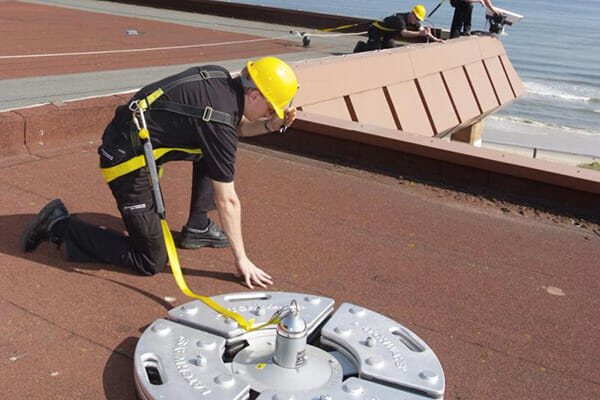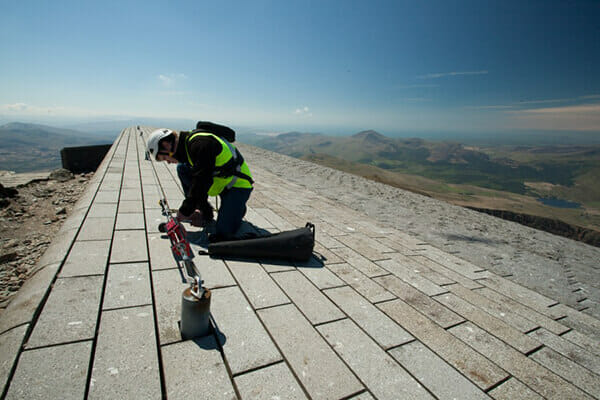Considerations when designing a fall protection system
There are many parameters to be understood when designing a fall protection system and these can be broken down into the following categories.
- Why do I need to work at height?
- What are the reasons for and what do I need to access?
- How am I going to achieve access? Access hatch, Ladder, Mobile Elevated Working Platform (MEWP)?
The first most obvious question is ‘why do I need to work at height and how you are going to access the system’.
The designer should decide on the safest means to access the area. If for example, the installation is a rooftop safety system, then the safest option would be through a roof access hatch or smoke vent. If this is not possible, then ladder access to the side of the building adds extra headache to the designer. If the access is by a fixed external ladder that is over 2.5m, then either a fall protection line or a hooped cage will be required.
If the access is via a portable ladder then one must consider the use of ladder tie bolts in which to secure the ladder in place. If none of this is possible, then the last route of access is a MEWP (mobile elevated working platform). If adopting this method then it is imperative that a detailed method statement and risk assessment be written and undertaken.
Once access has been decided, the designer must look at what the system is required for. In general, the rooftop safety system will be for gutter cleaning, maintenance of roof plant, or for general and basic roof inspection and should never be used for major works.
The best example is that a continuous cable will be installed around the perimeter of the building 2.3m back from the roof edge. The end-user will be attached via a 1.8m lanyard thus providing a ‘restraint’ system where the user is not able to reach the fall hazard and negates the risk of suspension trauma.
A cable-based system is considered the ‘last port of call’ regards fall protection as the safest option is a handrail. This provides ‘collective fall protection’ whereby the end-user requires no end-user training. Personal protective equipment such as harness, lanyard, or lifelines are not required and the works can be carried out freely and safely.
The introduction of cable-based fall protection systems was for areas where it simply is not possible either through space or planning restrictions for a handrail to be erected. Handrails have to be 1.1m in height and a cable-based system will generally be 500mm from the roof level.
It is a serious consideration that if you have a fall arrest system in place where the user can fall, you must have a minimum of 6.75m clearance beneath you. This is broken down as the distance of the lanyard to the system which will generally be 2m. The 2m free fall distance, the lanyard tear out and the clearance required under the user after they have been arrested.
If the system design is fall arrest, you must have a rescue procedure in place due to the risks of suspension trauma which can result in serious trauma to the body. There are varying studies and reports surrounding this, with suggestions that the user may only have between 6-12 minutes before there is a risk of death due to the harness points putting too much pressure on the body’s circulation points due to the build-up of dangerous chemicals within the body.
An effective fall protection system should be easy to use and user-friendly as this enables workers to carry out their jobs with minimum interference. The design process can be carried out by use of a site visit or the issue of drawings whereby your access requirements can be assessed correctly.
Our network of in-house structural engineers and designers can design each fall protection system to your specification requirements based on your access requirements. Our specifications include calculating pertinent factors such as dynamic load requirements, peak loading, and structural attachment points. The combination of these factors results in a properly designed and engineered fall arrest system.
We are fortunate to have a vast network of experienced engineers and designers who have designed a wide range of fall protection and fall arrest systems around the world including the Sydney Harbour Bridge, Dublin Airport, and Wembley Stadium to name just a few.
System designs have been carried out for sports stadiums, bridges, airports, power stations, telecommunication, towers, ladders, and all manner of establishments! The owner of this page has climbed the Sydney Harbour Bridge and even tried to get out of the hour-long induction on the correct use of the system, although the person carrying out the induction didn’t believe he was a fall arrest expert!
We will always work with you to provide optimal & safe solutions to keep you and your workforce safe!
Fallarrest.com has over 25 years of experience within the industry and has access to installers and designers around the globe, positioning us best placed to be able to assist and facilitate your requirements.
Did you know…
Horizontal lifelines should be designed, installed, and used under the supervision of a qualified person as part of a complete personal fall arrest system that maintains a safety factor of at least two. Do not take risks! Consult the professionals and don’t leave yourself exposed!
Choosing the correct fall protection system
All roofs will require safe access for general maintenance, plant servicing or renewal, gutter cleaning, and basic general inspection. Therefore it is important to consider safe access to the roof. There are several key design considerations to help you decide what you need to evaluate and consider when designing a fall protection system for your building and which is best suited to minimise anticipated risk;
- The competency of workers using the system.
- Does the end-user require training?
- The number of workers likely to use the fall protection system at any time.
- The number of time workers will spend connected to the fall arrest system.
- The frequency of use of the system.
- The areas of the roof which need to be accessed e.g. gutters, plant, and equipment.
- What parts of the roof pose a potential risk e.g. fragile sections of the roof, roof lights, gutters, etc.
- Where are the entry and egress positions of the roof.
- What is the roof pitch? e.g. the slope?
- Signage?
Best Practice
In the majority of cases unless specialist rope access is required (which is generally for window cleaners on high-rise buildings) it would be best to assume that the people accessing your roof will have minimal experience in the use of fall protection systems. The majority of end-users will be the school caretaker, the manager of a commercial building, the FM manager of a waste incinerator, and will require training.
Efficiency As Well As Safety whilst carrying out your work at height
All fall protection systems should allow for continuous hands-free movement enabling the operative to be attached at all times. Once attached to the system you don’t want the user to be able to disconnect as this has the potential to place them in immediate danger!
Safety For Any Roof
A range of fall protection system anchors is available to suit virtually all building structures and fabrics whilst remaining unobtrusive to protect building aesthetics. Fallarrest.com can offer a variety of systems to suit your requirements from toggle fixed-top fix posts to handrails to nonpenetrative weighted systems.
How The Law Is Tightening Up Roof Safety
Construction (Design & Management) Regulations – CDM
‘It is the responsibility of the employer’ to ensure that any employee required to work at height must be suitably protected from any potential fall hazard. In the event of a fall, the equipment used must be of sufficient strength to arrest a worker’s fall. HSE research shows that as many as one-third of building designers are still unclear about their responsibilities under CDM.
Work at Height Regulations 2005
There is a duty placed on employers, the self-employed, and anyone who controls the work of others at height to provide a safe method of work. A place is ‘at height’ if a person could be injured falling from it even if it is at or below ground level therefore this includes entering sewage drains, manholes, etc.





